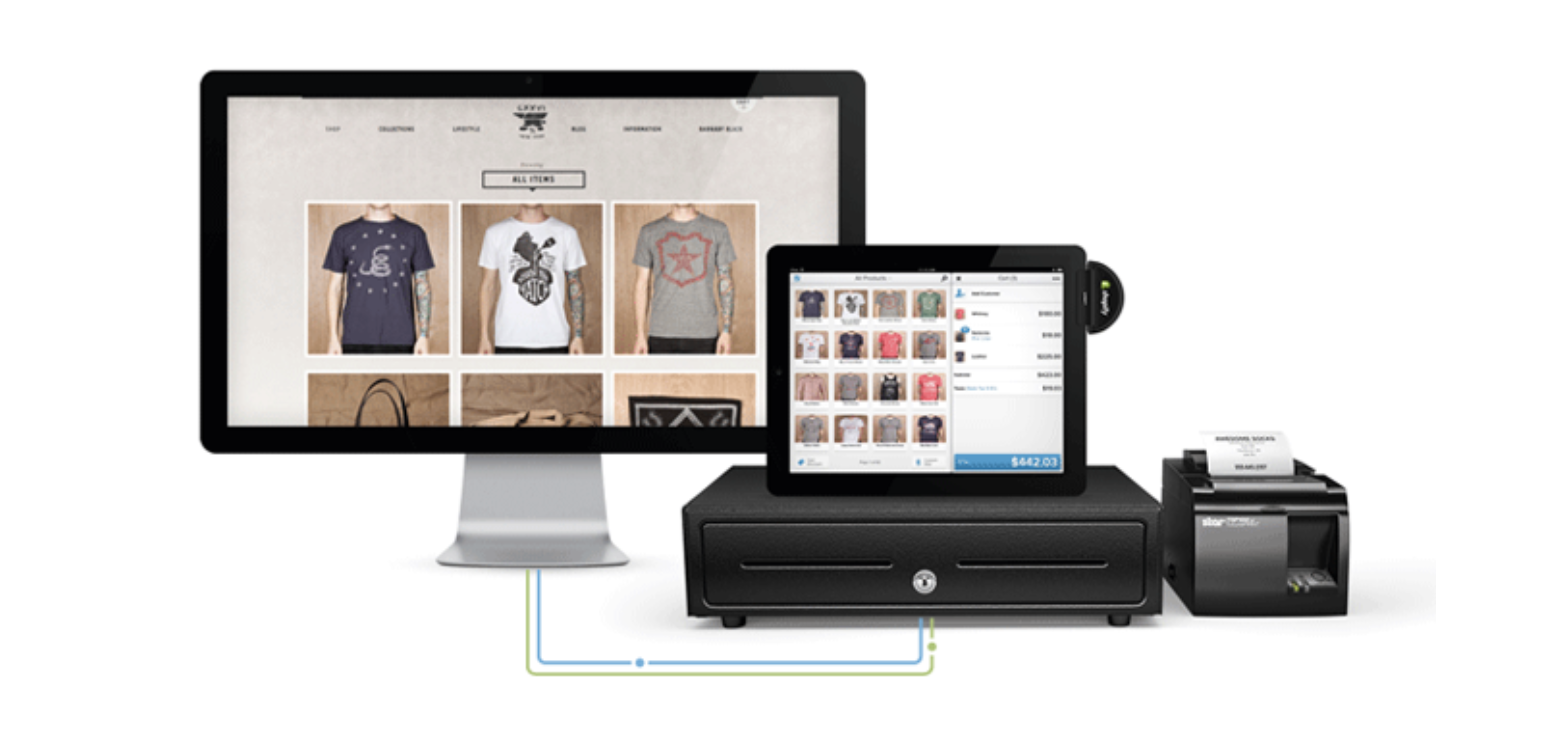How Shopify Grew From a Snowboard Shop to a $10B Commerce Ecosystem
When Tobias Lütke and Scott Lake decided to build an online store in 2004, they had no idea they would end up creating the world’s biggest e-commerce platform. All they planned to do was build a site where they could sell snowboarding gear.
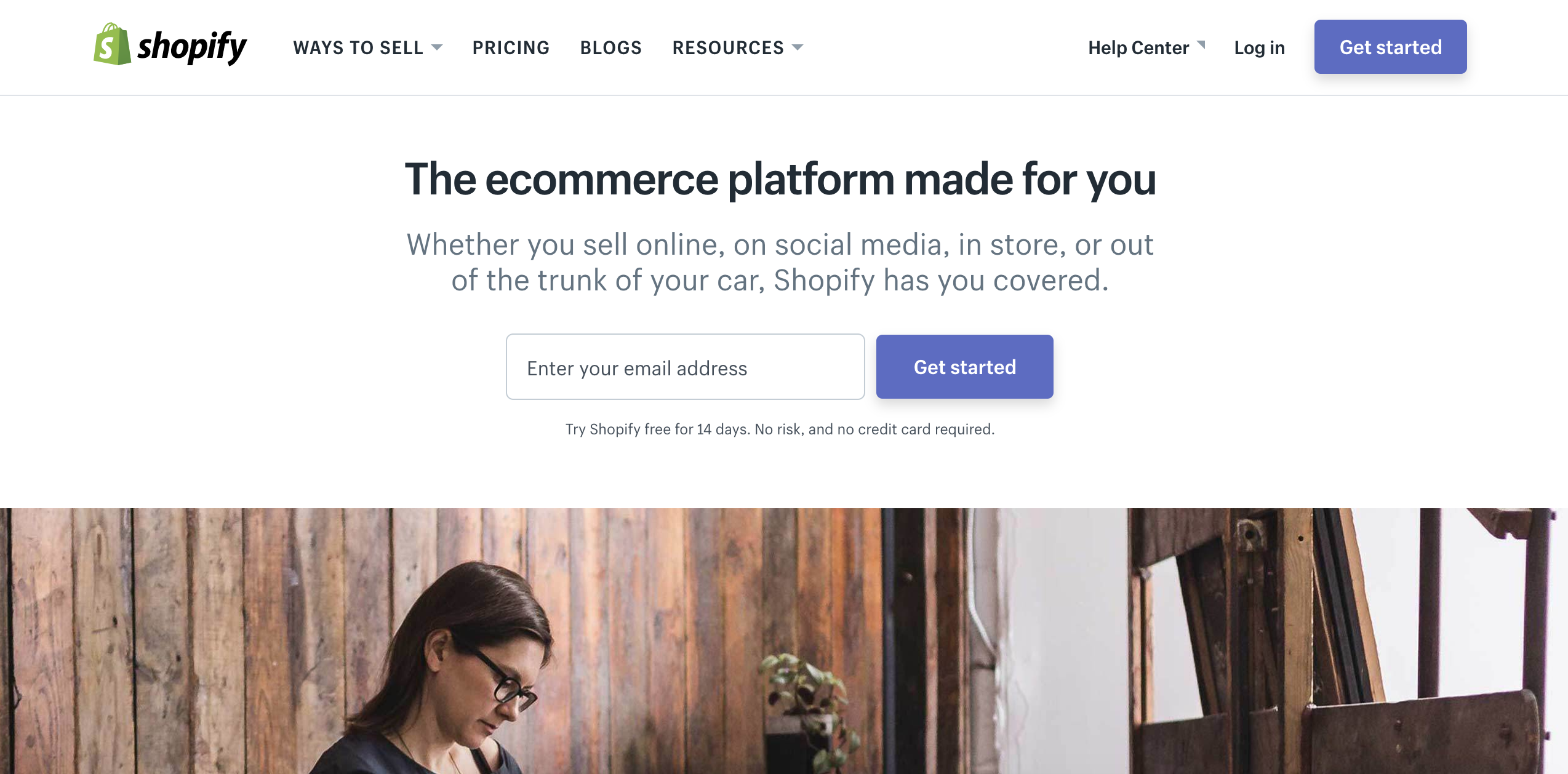
Today, their platform Shopify hosts over 325,000 shops for individual sellers and internet giants like Google and Tesla. The company generates over $20 million in revenue each month.
Unlike a lot of companies, Shopify was incentivized not just to sell their product to customers, but also to help customers become more successful on the platform. The more money customers made, the more money Shopify made. This drove Shopify to help their users become better merchants, and that’s the biggest reason they’ve grown to where they are today.
Let’s dive into how Shopify built a $10 billion business, and where they can go from here.
Evolving from tool to platform to ecosystem
Like many startups, Shopify started as a solution to a problem the founders had personally experienced.
Lütke and Lake wanted to launch an online snowboard shop, but they couldn’t find software that worked for them. Lütke described it this way:
“I set up our online store based on a variety of different systems such as Miva, OsCommerce, and Yahoo stores. Truth be told, all those systems made my skin crawl because of how bad they were. The final straw was when I got a custom design made for my snowboard store and I couldn’t get it to work in Yahoo stores. We had this great CSS-based layout done with all these new fanged ‘web standards’ and the customizability of Yahoo Stores barely allowed me to change the background color of the top frame.”
They decided to build the solution they wanted, and that product became Shopify. But they didn’t stop there. Shopify built a billion-dollar business by expanding from tool to platform to offline ecosystem.
To find out exactly what Shopify did to grow into such a successful business, let’s take a look at:
- How Shopify built their initial product to be simpler, faster, and more visually pleasing than other e-commerce sites at the time
- How Shopify expanded their product from just servicing sellers to being helpful to developers and the larger e-commerce community
- How Shopify plans to continue providing more simple sales solutions in the increasingly complex e-commerce space
Let’s take a closer look at how Shopify has grown by driving everything back to helping users become more successful merchants.
2004-2008: Giving small merchants the tools for e-commerce
“At the beginning, there was no grand plan.” —Tobias Lütke
Lütke was a software engineer by trade, but by 2004, he didn’t want to work as a programmer anymore—he was burned out. He decided to pursue a passion and open an online store called Snowdevil where he would sell snowboards from third parties.
Right away, he ran into a huge problem. Every tool that Lütke tried to use to build Snowdevil frustrated him. What he really wanted was a simple, user-friendly tool—one that didn’t exist yet.
Lütke decided that instead of using an off-the-shelf solution like Yahoo! Stores, he would build the online store infrastructure for Snowdevil from the ground up.
To do this, he used a new programming framework called Rails, which was created by David Heinemeier Hansson at 37signals (now Basecamp). This was really important for Shopify’s development in two ways:
- The Rails “bare bones” design principles informed the earliest version of the Shopify product. The early product had a lightweight interface and was simple enough for first-time e-commerce merchants to easily figure out.
- The Rails ethos influenced Shopify’s long-term strategy for succeeding and helping customers. Hansson developed Rails so that he could build a project management tool. Then he made the Rails framework and the project management tool available to other people as a product. Shopify did the same thing for merchants—Lütke built an e-commerce tool so that he could build Snowdevil himself. Then, he made the tool available to other people.
Lütke and his early team built an easy-to-use product where none existed and gave small merchants the tools to solve their own problems. This created a new market of people who had never been able to successfully sell online before—but now had everything they needed.
2004-2005: Around the time that Lütke and Lake were trying to build Snowdevil with off-the-shelf e-commerce tools, a friend told him about Ruby on Rails. Lütke fell in love with it—and the design philosophy behind it. It emphasized that tools should be easy and fun to use. This was exactly what Lütke was thinking when he tried to use the complicated and bulky e-commerce tools available at the time. After two months of building on Rails, the bare bones Snowdevil site was up and running.

Source: From an early version of the Snowdevil website.
They had a profitable season of snowboard gear sales in 2004, but the initial response to Shopify stood out to them even more than their store. They’d started passing their e-commerce platform around to some colleagues in the Rails community, and got a ton of inquiries about how they had built the website.
Lütke and Lake saw an opportunity to help other people sell online. They realized they were more interested in helping other merchants than running their online snowboard store. They shelved Snowdevil and refocused on creating a product that would help people build their own online stores.
In 2005, a programmer that Lütke knew, Daniel Weinand, joined the team. He was really interested in design, and Lütke and Lake wanted his help turning their idea into an appealing product. Together, they started building a set of tools for merchants.
2006: Lütke, Lake, and Weinand officially launched Shopify as a set of tools merchants could use to build their own sites. The initial product helped merchants get set up with customizable store templates, tracked orders in an RSS feed, and automated inventory organization. They also included basic but fundamental features like uploading images, adding tags, and grouping items. Payments could be processed through a PayPal or credit card processor integration.
All of these features were basic but essential to running an e-commerce store. For the first time, with Shopify, individuals who had never sold anything online before had the fundamental tools they needed to set up a successful e-commerce shop.
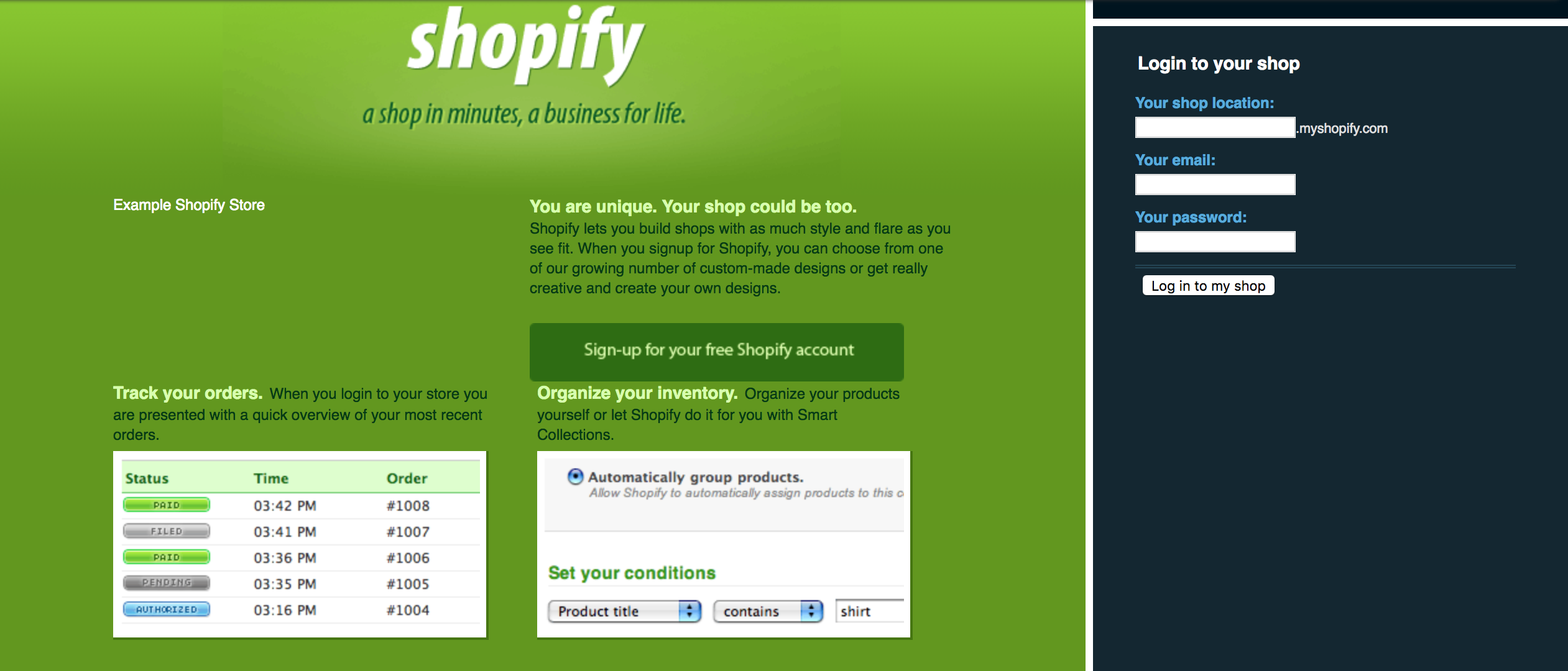
The website for the Shopify platform right after launch.
2007: Growth was slow at first. The company was making around $8,000 a month and had a very small customer base of some Rails community members and design-minded individuals from Weinand’s circles. But the most important thing was that they had paying customers.
In an interview, Lütke called this year a turning point because the company changed the way they charged customers. Previously, they had charged transaction fees as a percentage of sales—which actually discouraged merchants who would be making more money on their Shopify store. They switched to a subscription-based plan and tacked on a small transaction fee that decreased as plan size increased. This way, Shopify still saw a cut of all of the sales happening across their tools, but they also incentivized greater sales revenue for customers.
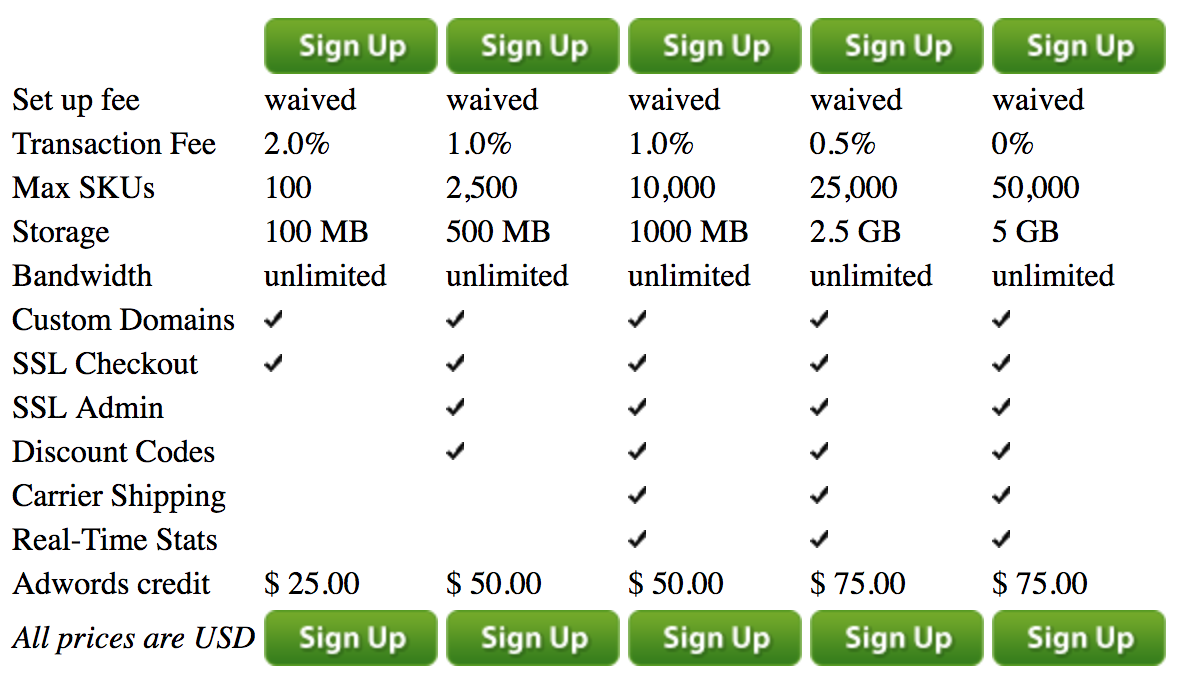
Source: From an early version of the Shopify pricing page.
This is when the alignment between business model and customer success fell into place. Shopify now focused their product development on building features that helped customers sell more because every sale for a customer meant more revenue in transaction fees for Shopify. For instance, they built analytics into the product to help merchants track their inventory and sales, which early users loved.
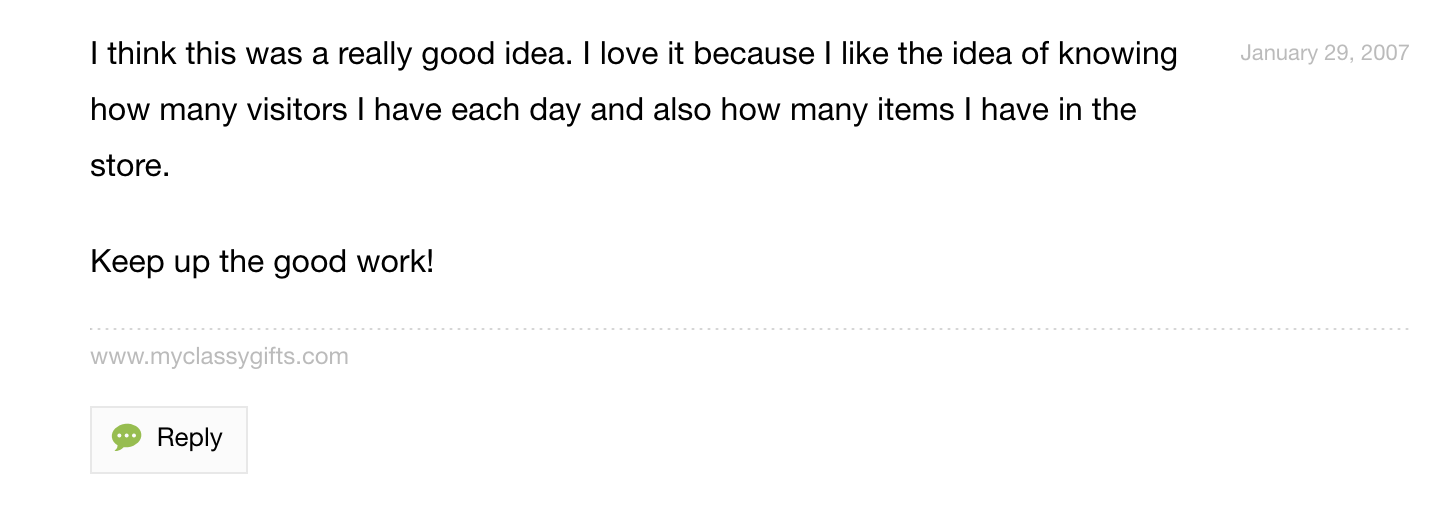
Source: A review of the new e-commerce analytics on a forum after launch in 2007.
That same year, a Toronto-based angel investor John Phillips wrote Shopify a $250,000 check. He valued them at $3 million.
2008: Shopify nailed the alignment between an easy-to-use product and beginner-friendly branding. The company’s website and content emphasized ease of use and offered helpful tips. Shopify saw their customers’ success in their own bottom line—the company was now doing $60,000 in MRR.
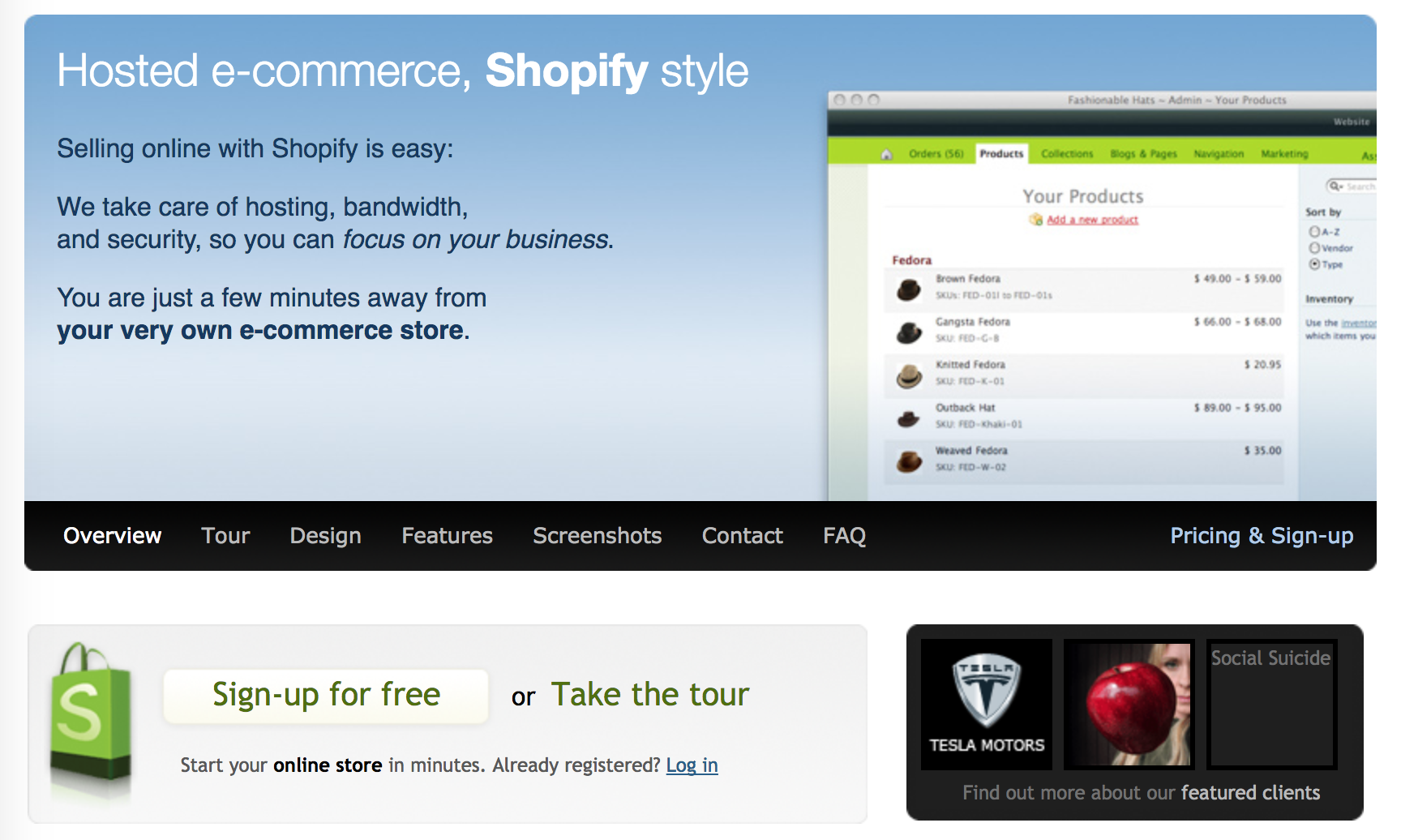
Source: Shopify homepage in 2008.
At this point, Shopify was focused on giving first-time sellers the basic building blocks they needed to move merchandise online. Tracking orders, managing inventory, and having basic analytics capabilities were the most important core features for first-time sellers, and they were the first ones Shopify created.
But even larger and more experienced merchants, like Tesla Motors, had a reason to check out Shopify. Their software was cheaper and easier to use than the other options available, like Microsoft Commerce and Yahoo Stores. With this in mind, Shopify demonstrated how they could cater to sellers of all needs and sizes.
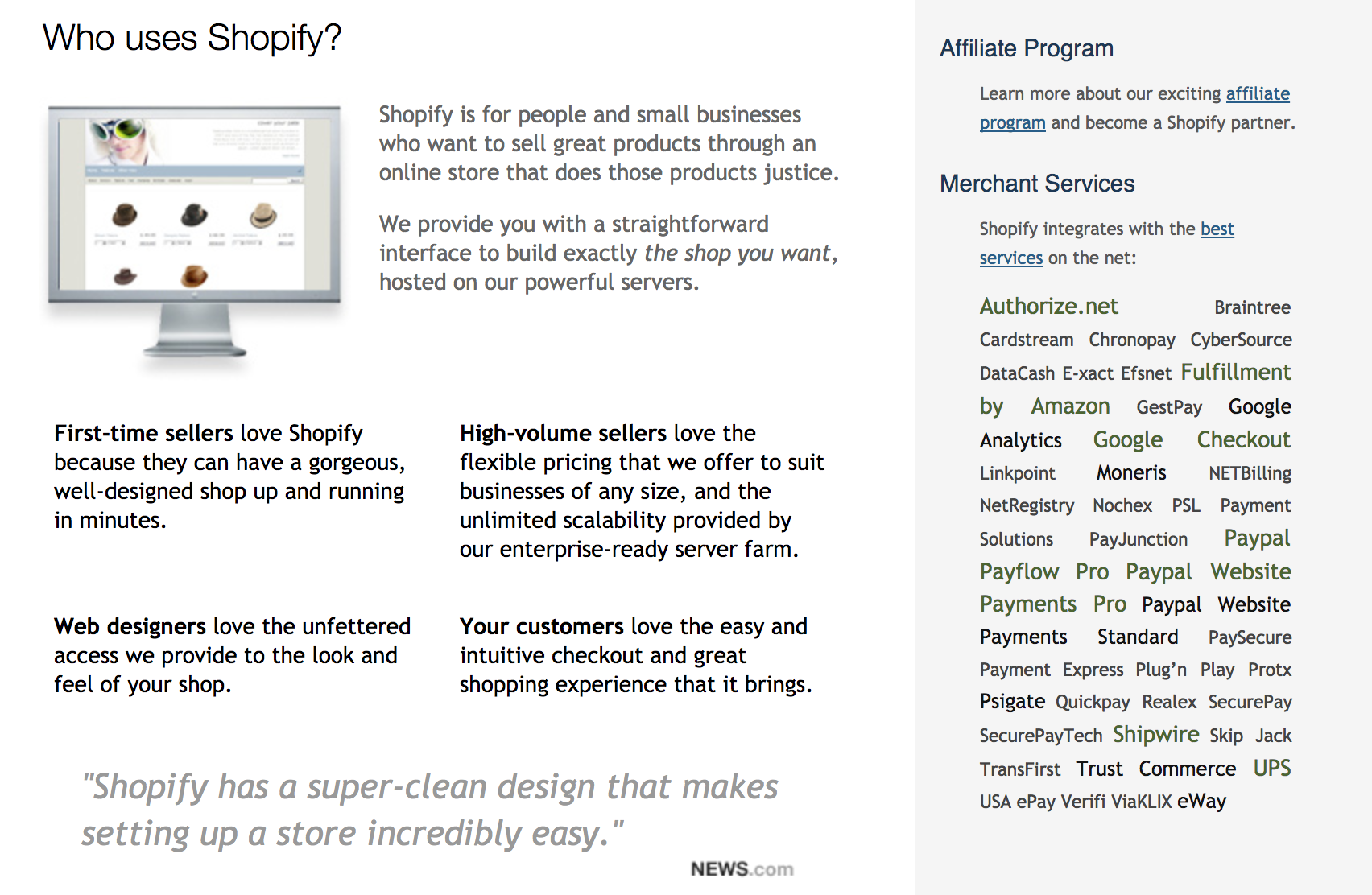
Source: From the 2008 site.
One of the subtle brand hallmarks of Shopify during this time was accessibility. In addition to making the product as intuitive as possible, the company also created simple guides and extensive FAQ pages to help users sell online. This helped new merchants sell more and gave almost anyone the ability to be a Shopify user.
But Lütke and Weinand saw potential for an even bigger market. They knew from their own developer backgrounds, and from talking with friends in the developer community, that people might be interested in building out their own customizations and apps for Shopify stores. If the Shopify team could create a platform for people to share and sell those apps, they could take a cut of those transactions.
2009-2013: Building out a toolkit for selling online
Lütke and Weinand’s developer backgrounds—and their focus on helping a broader base of users—enabled them make a critical transition from tool to platform by building an API and an app store.
At the time, they just saw this as an opportunity for like-minded developers to sell their apps. It was also a chance to give Shopify merchants more customization options. But this move was pivotal to Shopify’s growth because it helped them expand when other web businesses were shrinking.
Many contemporary web businesses failed to make the transition from tool to platform like Shopify did. The 2004-2008 wave of software tools made the web a friendlier place by creating simple tools that did one thing really well. At first, these tools were valuable because they were simple and streamlined. They replaced old tools that had complex user interfaces with bloated feature sets.
But when these companies couldn’t expand beyond being simple, delightful tools, they were acquired and folded into larger companies. Here are just a few examples:
- Flickr (founded 2004), the photo and video sharing site, was acquired by Yahoo! in 2005 for $35 million
- Digg (founded 2004), the news aggregator, was sold in three parts in 2012 for around $16 million
- Feedburner (founded 2004), the web feed management provider, was acquired by Google in 2007 for $100 million
- Delicious (founded 2003), the social bookmarking service, was acquired by Yahoo! in 2005 for between $15 million and $30 million.
These companies didn’t make the critical transition from tool to platform. But, Shopify did. And it started with the release of their API platform.
2009: On the company’s third birthday, Shopify released an API platform and app store. Both were meant to help the existing base of Shopify merchants and a new base of developers. In the press release, Lütke said:
“E-commerce is a highly individualized business. Every store wants to offer a unique buying experience but providing too many features makes the software cumbersome and difficult to use. The Shopify API solves this by allowing merchants to install exactly the features they need to get the most out of their store…and our Partners can get a recurring source of revenue by developing great applications for these stores.”
That meant even more people and businesses became invested in the e-commerce platform.
In the app store, developers could sell their apps and merchants could browse, buy, and directly install apps. Now merchants had ways to quickly customize and improve their online storefronts.
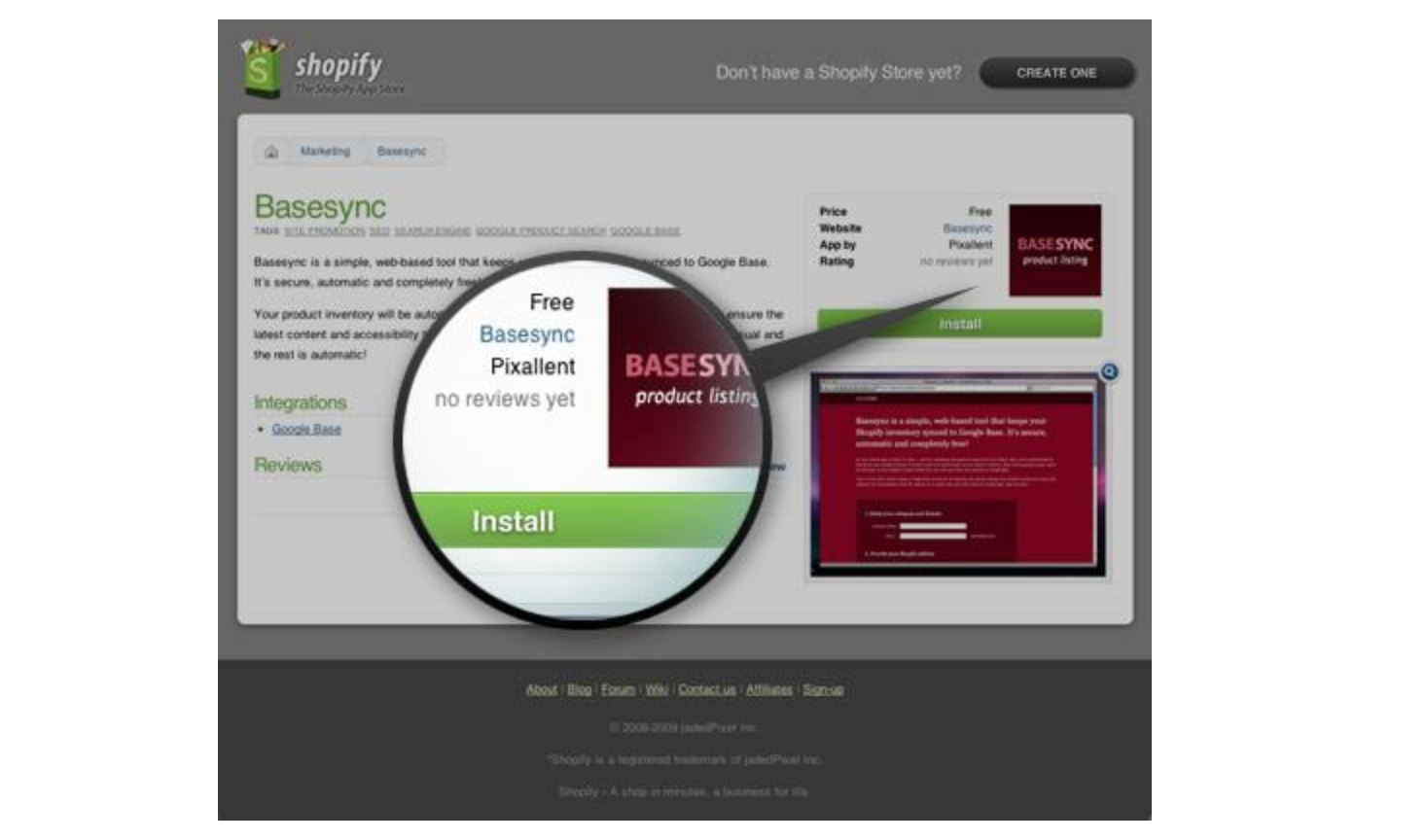
Source: How to install apps from the App Store, shown in the 2009 blog post about the release.
The option for merchants to cherry-pick the most helpful add-ons helped Shopify stay true to the original premise of the product: easier e-commerce for everyone.
2010: Shopify released a free app and gave merchants yet another way to manage online sales. Shopify Mobile was a game-changer because it allowed sellers to monitor their online stores, look up customer information, and fulfill orders from their phones—just as “m-commerce” was on the rise. From 2009 to 2010, global smartphone shipments grew by 74%. More people were getting smartphones and buying and selling online. This was a huge opportunity to command a new channel, and Shopify was on top of it.
Shopify also stepped up their efforts to promote e-commerce by launching the “Build a Business” competition. This contest challenged storeowners to start a store over an eight-month period. They created high stakes to fuel enthusiasm: the most successful company would win $100,000 and get mentorship from celebrity entrepreneurs.
The contest inspired over 1,000 new online stores, generated over $3 million in revenue across those new stores, and fueled stories in the New York Times.
2011: Shopify was now supporting 11,300+ stores, and generating over $125 million in revenue across those stores. With so many users of all levels, Shopify wanted to expand access to professional support. They released Shopify Experts, which was an “online directory of experienced Shopify pros” that had extensive knowledge of Shopify and could pass down advice to less experienced sellers.

Source: The release of Shopify Experts.
2012: From 2011-2012 Shopify saw 61% growth in new stores (up to 18,200) and over 2.2x revenue growth (up to $275 million in sales across all stores).
2013: Shopify unveiled a major platform redesign, Shopify 2, that included over 60 new features. They’d sourced feedback from their customer base—now over 50,000 merchants—and added updates like refund management, better search functionality, easier-to-use admin features, and a live theme editor. All of these aspects of the redesign were focused on making it easier for merchants to manage a store on the Shopify platform.
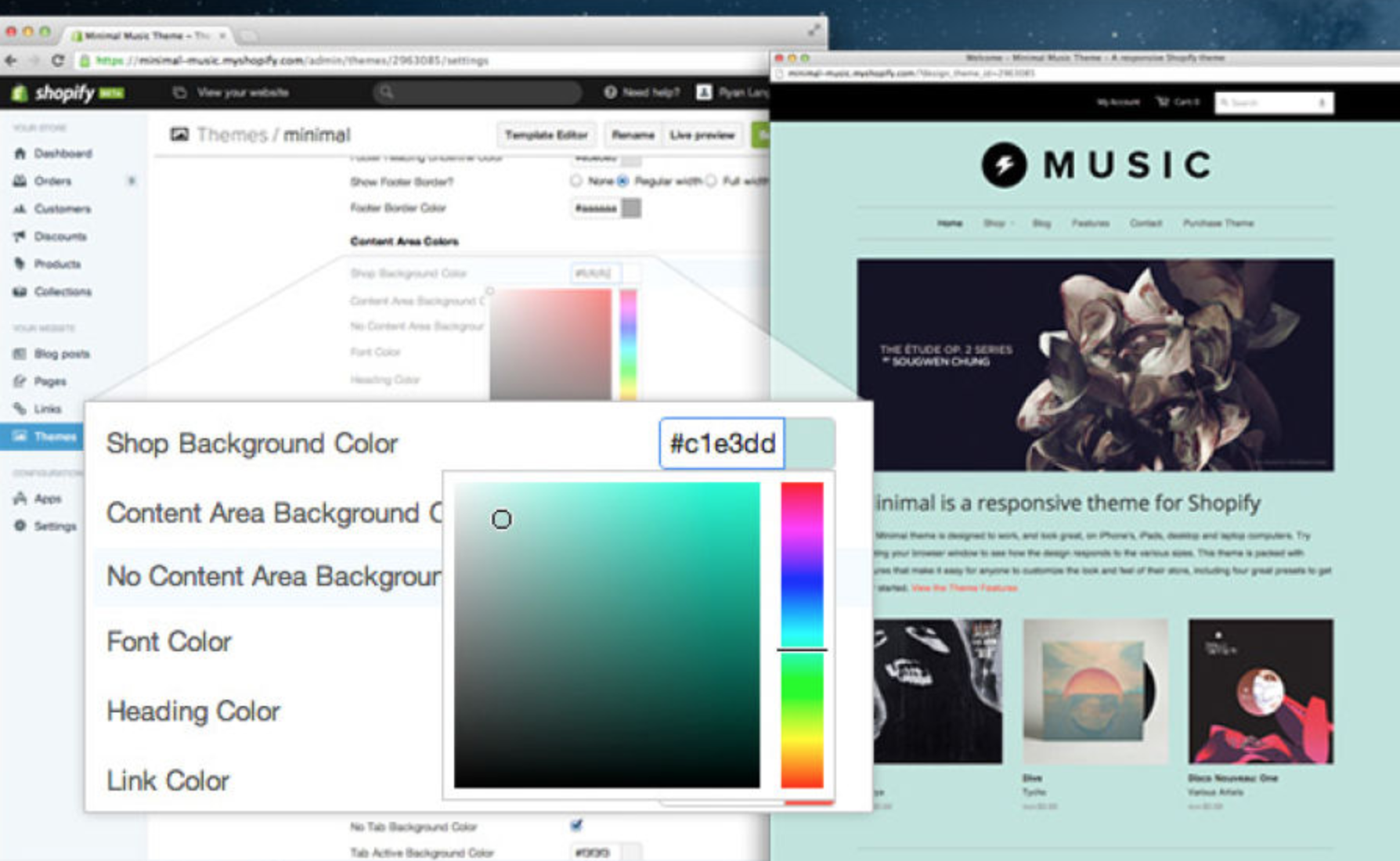
Lütke said in a press release that this redesign was helping Shopify to “redefine how e-commerce works,” and that Shopify was “moving into a less traditional mentality of how we think about building webpages.” Shopify 2 helped designers prototype and release new stores and applications very quickly.
By the time they raised their $100 million Series C round in 2013, Shopify wasn’t just a tool that a retailer might choose among many tools to sell online. Shopify created an app ecosystem and a developer community, and turned themselves into an approachable authority on succeeding at e-commerce. The company had woven itself into the very fabric of doing business online.
2013 was also pivotal for Shopify because they started paying attention to how their merchants were selling offline. They released Shopify POS—which offered in-store and online inventory synching, out-of-the-box credit card processing, and reporting for merchants selling in brick-and-mortar shops. The new Shopify Payments feature was bundled in, too, so merchants could sync payments on- and offline.
During this period, Shopify was taking all of the necessary steps to double down on making merchants more successful and growing the number of online transactions. But they were also beginning to look to a completely different space for growth: offline commerce.
2014-Present: Expanding beyond the online storefront
When Shopify built POS in 2013, it gave merchants more tools for managing sales and provided another way to drive more revenue across the Shopify platform.
But POS wasn’t just another helpful feature. It was an important moment for Shopify, helping to expand their scope yet again. This time, instead of expanding on the internet, they wanted to capture commerce that was still done offline.
This meant redefining the company’s focus from product to mission. At first, Shopify’s vision was very product-centric. Their goal was, “making it easy for anyone to create a beautiful and powerful online store.” The earliest customers appreciated these tools and the platform. But to continue growing, Shopify expanded their vision to an even wider audience. Instead of focusing only on e-commerce software, which benefitted online sellers, they worked towards “making commerce better for everyone.”
This applied to people selling anything, anywhere—not just people building online stores. When they announced their Series C, the founders said:
“Shopify began as an easy way to sell products online. We used our previous funding rounds to expand into new areas that enriched our product and helped our merchants, like payments and mobile…This new round of funding will help us further expand into physical retail with POS, so our merchants can easily sell their products anywhere, at any time.”
Shopify expanded from product-first to movement-next by refocusing from their e-commerce tools to a broader mission of helping everyone sell on- and offline. Now they’re getting into more distribution channels and casting a wider net. And as long as they get a cut of each transaction, the company is confident that making all forms of commerce easier will keep driving the company’s growth.
2014: Shopify overhauled their app to accommodate offline sales. The new Shopify Mobile synched with Shopify POS. The app allowed merchants to accept payments with their phone in retail stores as a second register, add and edit inventory listings, and automatically update changes back to physical retail locations.

Lütke called Shopify’s new focus on mobile e-commerce a pivot to becoming a mobile-first company. And they did it at exactly the right time to capture the most value from their market. In 2014, when the company brought POS to Shopify Mobile, for the first time in history over half of all e-commerce traffic came from mobile devices.
Shopify also started doubling down on their services for larger merchants. This same year, they introduced Shopify Plus, a white-glove e-commerce service for merchants selling high volumes of inventory. It offered unlimited bandwidth, more storage, more customization options, and priority account management. They framed it as a way to help customers that grew with the platform, not a way to move upmarket. This was important because the company wanted to expand their customer base, but didn’t want to alienate the smaller users that were so valuable to their brand.
2015: Shopify introduced Buy Buttons as a way to sell things from any website—not just an e-commerce storefront. Users can add Buy Buttons to their websites that they make with WordPress, Squarespace, and Tumblr.
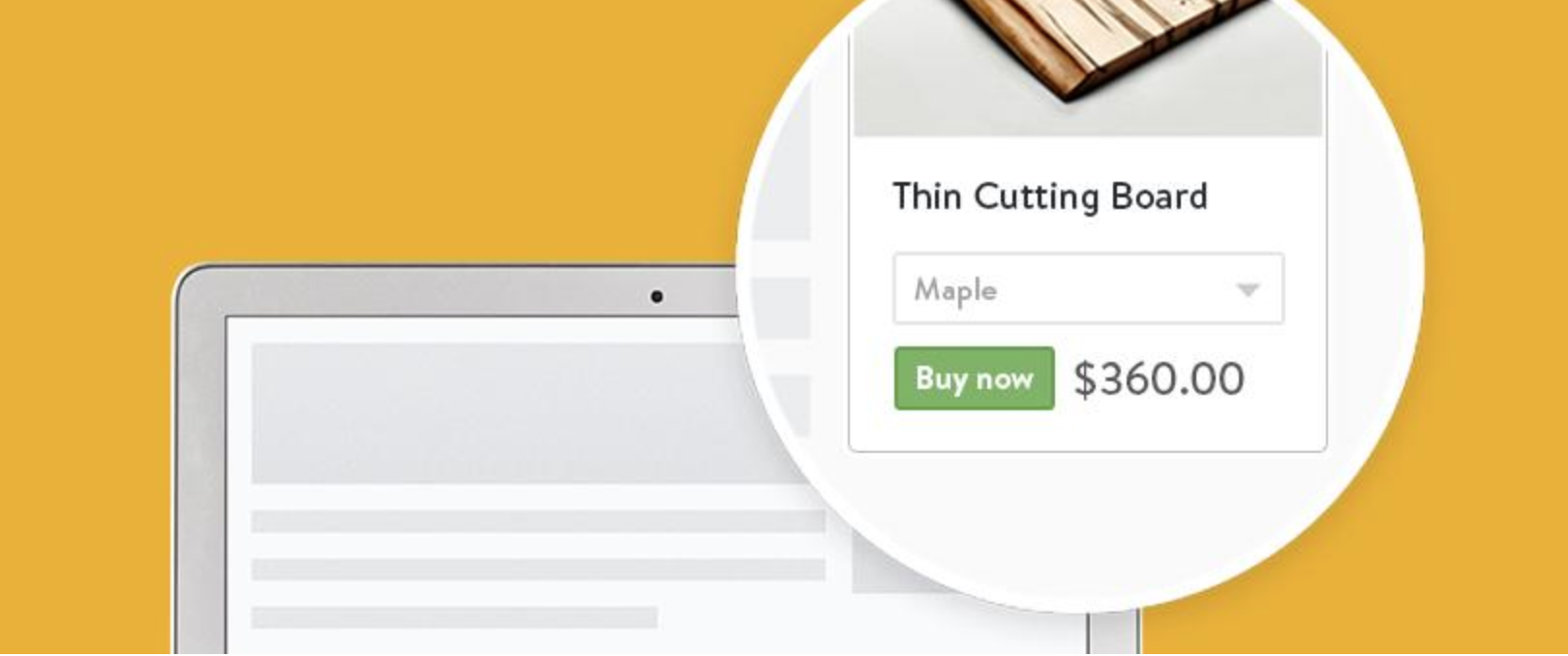
With so many ways to sell with Shopify—including the e-commerce storefront, POS, and buy buttons—merchants needed a centralized place to manage their sales. So the same year, they added Multichannel Shopify to the platform, which included a dashboard for merchants to manage sales across multiple channels.
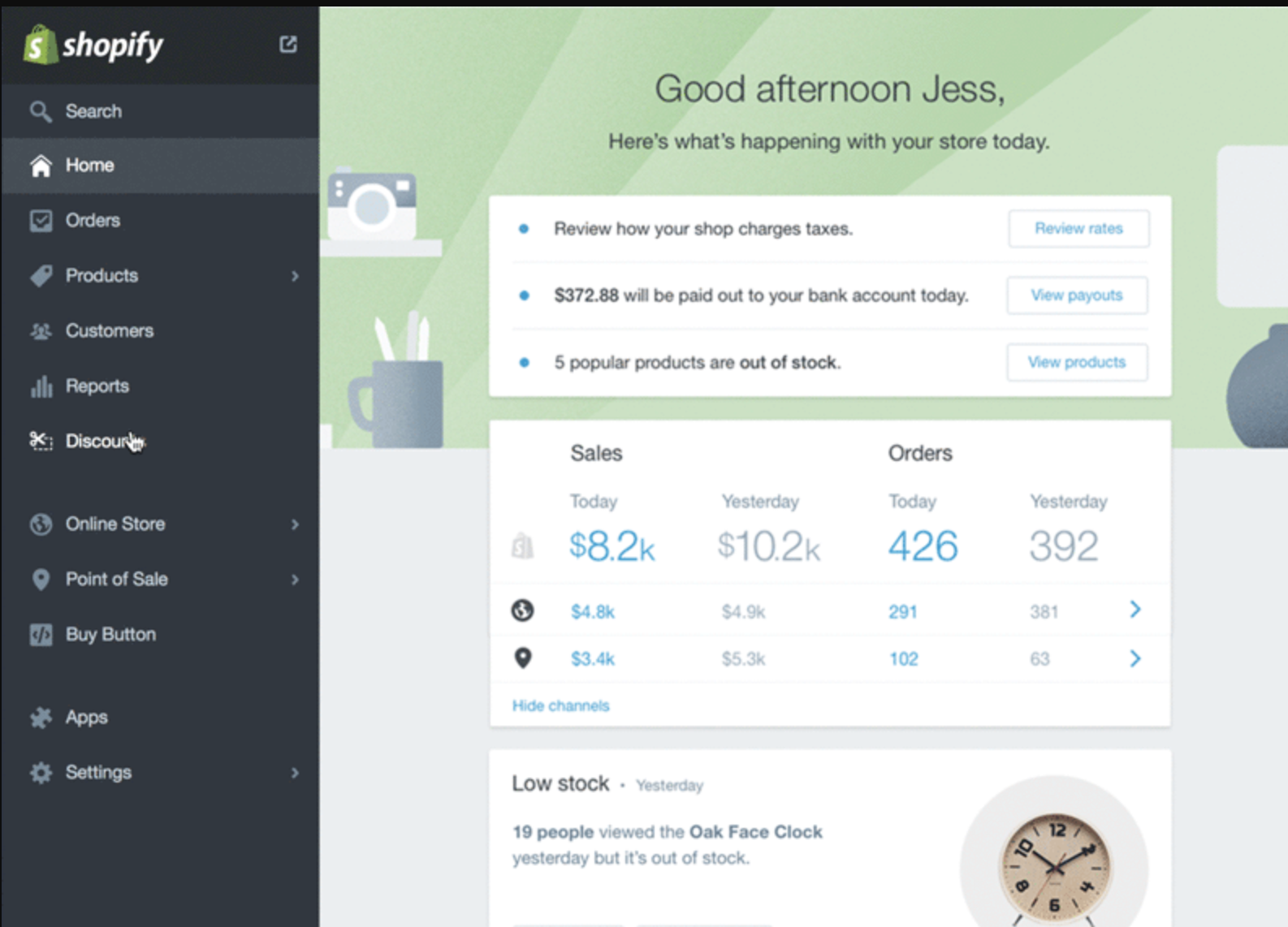
Source: Shopify Multichannel dashboard in 2015.
2016: To merge the personalized touch of offline commerce with the convenience of e-commerce, Shopify introduced an integration with Facebook Messenger. Merchants could communicate with customers about orders and give them real-time service in a more personal channel.

2017: Shopify closed the gap between online and offline shopping even further with Shopify QR codes. These allow shoppers to scan a code on a physical item with their phone camera and directly access the item in the merchant’s online store.
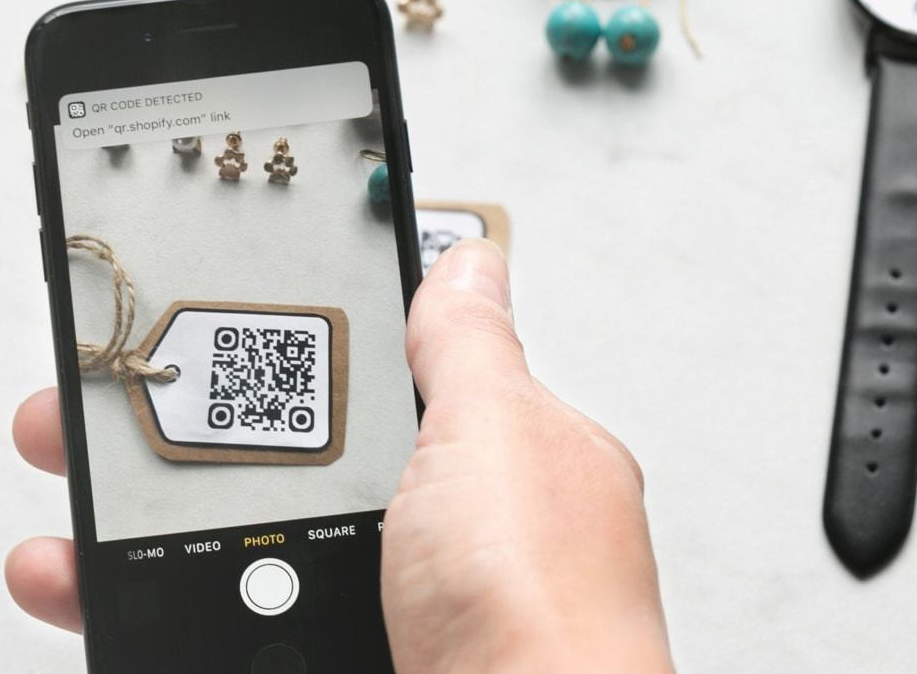
Earlier this year, Shopify also took a huge leap by making some of their most advanced e-commerce software features available to all of their users, for free. Shopify integrated with the virtual assistant Kit in 2016, but the feature was only available to users on certain subscription plans. Now, Kit is available to everyone for free, which will help more merchants sell more goods with less effort and less spend on store maintenance.
Over the past few years, Shopify’s product expansion has centered around making offline and online commerce easier to sync and manage. But even though the new product features are expanding merchants’ reach, Shopify is careful to maintain the personalized touches that come with small business sales.
They pioneered the idea of “conversational commerce” with their Messenger integration. The feature was not a bot or AI—by design. Instead of detaching the merchant from the customer’s experience, it brought them into the experience more closely. This was really important to small business owners who were used to selling offline, and helped to reduce some of the friction of moving between online and offline commerce.
Adjusting for offline commerce has been a huge driving factor of growth from within. It has allowed merchants who previously only sold online to sell offline, too. As a result, Shopify can monetize their existing customers better simply through a greater volume of transactional fees.
From 2013 to 2016, revenue from merchant services grew from 20% to 50%. The average subscription payment per merchant didn’t change by much—each merchant wasn’t upgrading their plan or paying more. But the average contract value increased because Shopify collected more service charges per billion dollars of GMV.
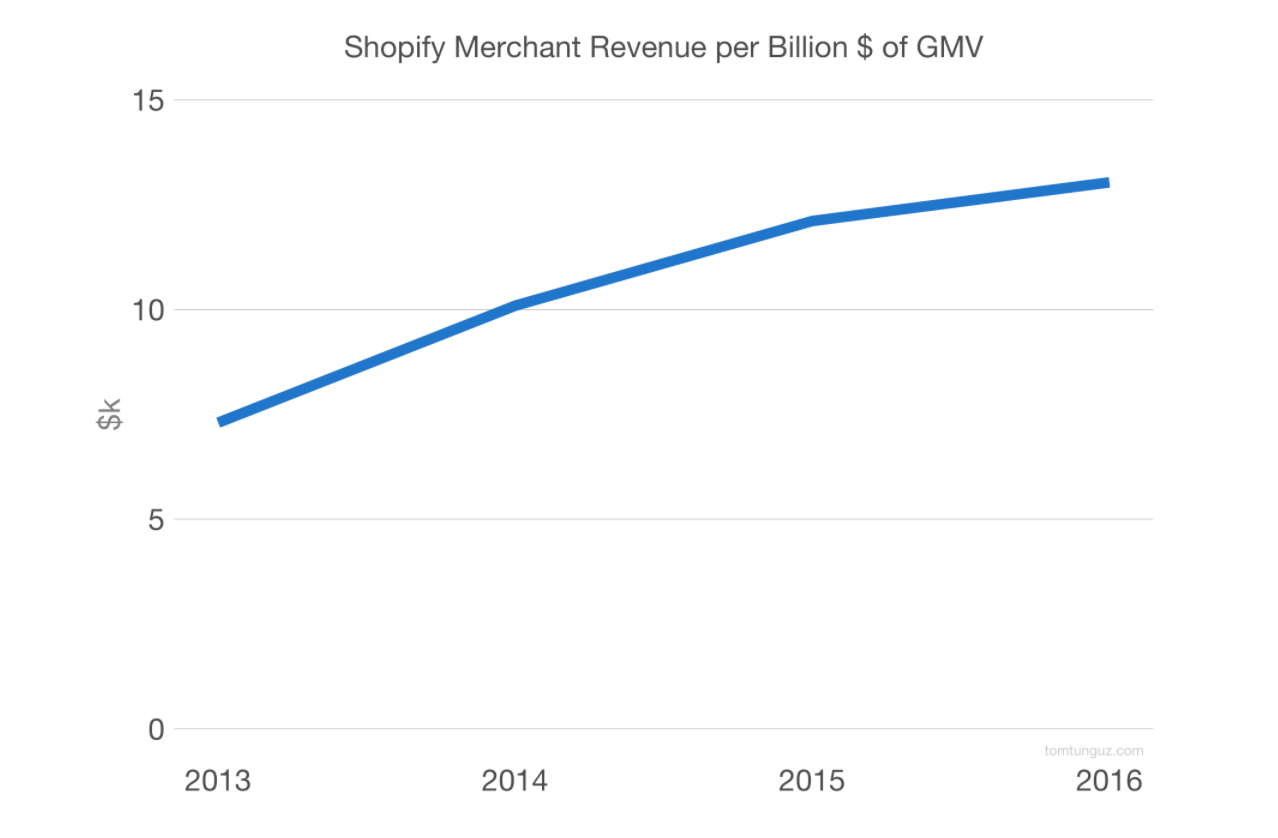
Source: Merchant services revenue generated per billion dollars of gross merchandise value by Shopify increased from 2013 to 2016.
And strategically, with Shopify Plus, Shopify made sure that merchants wouldn’t outgrow their platform even as they increased their volume of sales. No matter what the size or selling activity of the merchant, Shopify could provide a helpful tool to make it easy for them to sell more.
Where Shopify Can Go From Here
Shopify has been working with online merchants for 13 years, but they only just started cracking into offline markets.
The space for commerce tools is competitive, but Lütke says that embracing external change is a core value for the company and pushes them to keep innovating. In an interview this year, Lütke noted, “What we value is not predictability and all these kinds of things. What we value is how quickly we adjust to the new realities.”
Here are the new realities Shopify is facing, and a few ways they can expand in the future:
- Expanding to personal interfaces outside of the store: Shopify has invested early and often in conversational commerce. Acquiring Kit CRM in 2016 was a huge move. So was their launch of a commerce communication channel in Facebook Messenger. Shopify is betting on a future where people buy and sell more stuff through personal and text-based interfaces like Messenger and WhatsApp. While this has been slow to take off in the states, in China, messaging platforms like WeChat are the virtual wallets and hubs of commerce. Messaging is a high-volume, high-transaction ball game, which suits Shopify’s business model perfectly. If it takes off, Shopify will have the first-mover advantage, greasing the wheels of commerce on messaging platforms.
- Moving upmarket: While Shopify began by empowering small businesses, one of its largest opportunities to grow in the future is to move upmarket and compound annual contract values by selling to the enterprise. In 2016, Shopify acquired product-development shop Boltmade to accelerate the development of Shopify Plus. Since then, they’ve ramped up the development of enterprise-friendly features, like marketing automation and multi-channel sales. They even created a customizable backend for tracking inventory and integrated it with pre-existing systems. Shopify can increase their subscription value from enterprise contracts by adding more marketing automation features that the merchant can view within the same suite of tools as their inventory management and multi-channel analytics. They can also continue to create a more customizable backend to give the largest and most nuanced companies the flexibility to build on top of the Shopify platform.
- User-facing machine learning and AI: In 2016, Shopify launched their Merchant Cash Advance Program called Shopify Capital to give merchants a fast, simple, and accessible way to secure financing for their store and move on to the actual selling. This tool uses machine learning to assess the risk of U.S. merchants and generate custom reports on their eligibility. It has been an incredibly useful way for them to use the data they collect to help merchants even more by assessing their eligibility for loans. As one analyst reported, “Shopify has been generating large volumes of data across a variety of data types and at significant velocity, as the company saw +12B interactions on its platform in Q1/17 versus +35B in 2016.” They have the potential to start bringing machine learning and AI directly into add-on features that merchants can use on the front-end. Some potential applications could be product recommendations for customers and segmenting and targeting for online marketing.
At the end of the Q2 2017, Shopify reported 75% YoY revenue growth. The company sees their success as tightly tied to their ability to adapt to changing market demands. Russ Jones, the CFO, said, “The fundamental shift in retail toward multi-channel and mobile, the ongoing adoption of Shopify by larger brands, and our continued focus on building out the market-leading platform for sellers all contributed to the strength of our results.”
If they can keep up with these shifts to help both large and small customers sell more inventory, Shopify is in a strong position to continue growing.
Lessons Learned from Shopify
Shopify has set up a SaaS business that sustains on subscription fees and growth with transactional volume. But they’ve also been successful because of their ability to anticipate what the market will want and respond quickly with helpful products.
If you’re building a business today, here are some key lessons that you can take away from Shopify’s journey:
1. Align your product, your business model, and your company goals
One of Shopify’s greatest advantages is that its business model is aligned with helping customers become successful. The more sales Shopify customers make, the more money Shopify brings in. That’s a great way of aligning everyone in the company, from the product team to customer support, with a focus on helping customers win. Everyone is benefitting, so everyone is invested in constant improvement.
When you’re building a company, one of the most important ways to drive alignment is to choose a single compass metric, or the primary company-wide metric used to measure growth. Lütke calls this metric “the motor of a fast-growing multi-million dollar venture backed business.” Shopify’s compass metric is Committed Monthly Recurring Revenue; they have many incoming revenue streams, but their bottom line is directly tied to retaining a base of happy and successful merchants. Lütke believes CMRR is a good indication of a happy and loyal customer base, so he uses this metric to drive incentives for his team and prioritize the best results for customers.
To create alignment around your compass metric, Lütke first recommends these high-level steps:
- Choose the metric to focus on depending on the stage of your company and what you’re trying to accomplish
- Choose a time frame that allows for a tight feedback loop
- Design the user interface that you’ll use to keep your team informed
A lot of other companies have put this into practice. Patrick Campbell at Price Intelligently evangelizes Lütke’s ideas about compass metrics to other SaaS businesses. At Price Intelligently, they’ve implemented two ways to create accountability around the compass metric that they recommend to companies:
- Send out daily emails to track progress on the compass metric
- Hold weekly meetings for team members to share what they learned that week and how they plan to improve the metric the following week
2. Relentless Prioritization of Product
Though many of Shopify’s product innovations seem obvious after the fact—like creating a drag and drop theme builder, or building messaging products—a big part of the company’s success is due to them focusing on the right thing, in the right sequence.
They built a really helpful tool which gave them a wedge into the online merchant market. Then, they built a platform, which allowed them to create a network. Finally, they built an ecosystem—both on- and offline. The order mattered because each step built on the success of the previous one.
Prioritization is critical, even if you’re still focused on building your product and haven’t reached a larger platform or network stage. If you’re building a product today, Shopify Product Director Brandon Chu advises a quantitative framework for product prioritization based on two data points:
- Amount of customer value
- Amount of time it takes to finish a project
Determining these two factors for each project will help you determine the customer value return on your time investment to build.

Source: Black Box of PM
Things like customer value will have to be quantified based on your specific product. Customer value might be dollars saved, or it might be time saved. Either way, when you divide the value by the time it will take your team to build that feature, you’ll understand how much time or money you’ll be saving your customer per hour of your work time. This is a useful way to compare and maximize how much value you’re creating for your users over time, and make sure you’re setting yourself up for the best next move.
3. Embrace long-termism
Building a product and a company always requires some trade-off between long-term and short-term value. Shopify has stuck to long-term priorities. According to Lütke,“Great product people understand how a change in the way the world works will impact the log files. And they can perceive that impact in real time.”
Shopify’s journey to $10 billion has been a hard-earned one. It took them over four years to reach $1 million ARR, and eight years to reach $100 million ARR. But along the way, they have always prioritized decisions that benefit long-term relationships with their sellers rather than those where they could turn a short-term profit.
For example, Shopify decided from the beginning that all storefronts were going to be hosted on their own servers, which put them all behind a fast CDN. Other companies, like WordPress, give users the option of self-hosting, which might have reduced overhead costs for Shopify. But providing hosting removes a layer of complexity for their novice merchants who aren’t trying to troubleshoot hosting issues themselves. It sets the foundation for relationships with extremely new sellers.
Here’s a framework I find useful for helping founders think beyond next month’s MRR:
- What is your product’s value proposition, and what is its time to value?
- What is the competition like in the space?
- What is each of the target customers worth? What is the potential market value?
- What is the quickest way you can help your customers win?
The future of Shopify
Thanks to Shopify, anyone can launch an online storefront from their own computer. Merchants have more ways to get in touch with customers, learn what they want, and sell them items online or in physical stores.
Shopify has also changed commerce potential for consumers. Thanks to the ease of setup and maintenance of online stores, the number of e-commerce shops has exploded. That means more choice for consumers, more competition that drives up quality, and in many cases better relationships with storeowners and brands.
Shopify has enabled hundreds of thousands of people to become merchants and consumers in ways that they couldn’t before. And by building their business model around customer success, they’ve secured their own growth machine. What comes next depends on how well the company can anticipate market changes and rise to the occasion. If history is any indicator, they’ll be ready.

